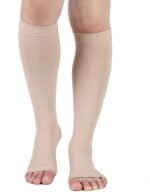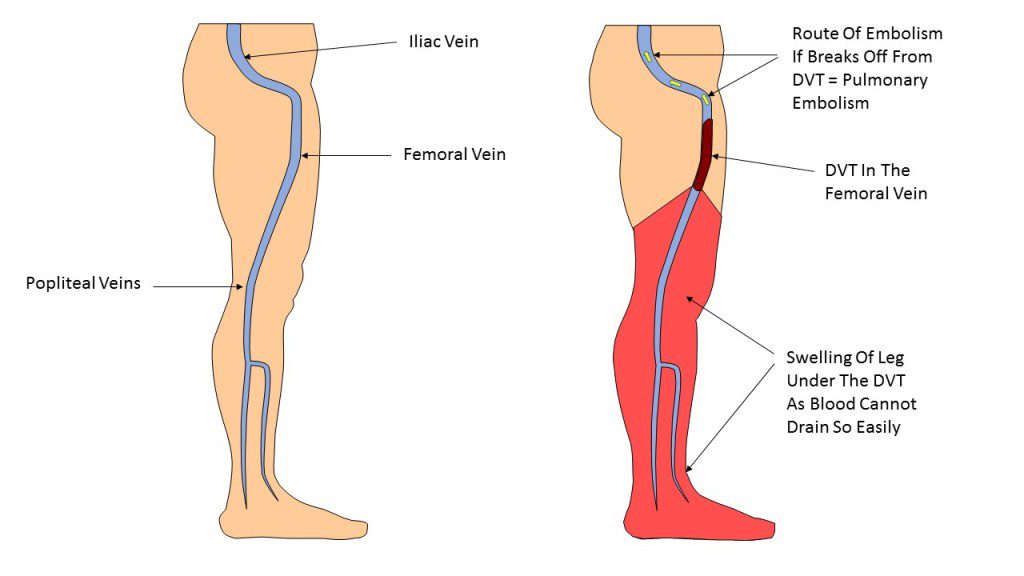As healthcare professionals, we understand the importance of DVT prophylaxis in patients. Deep Vein Thrombosis (DVT) is a serious medical condition that occurs when a blood clot forms in a deep vein, usually in the legs.
If left untreated, it can cause severe complications such as pulmonary embolism (PE), a potentially life-threatening condition.
DVT can happen to anyone, but certain risk factors can increase the likelihood of developing this condition. Patients who are hospitalized for an extended period, have undergone major surgery, or have limited mobility due to a medical condition are at an increased risk of developing DVT.
Preventing DVT is crucial, and there are several methods for DVT prophylaxis that can help reduce the risk of blood clots. In this article, we will discuss the different methods of DVT prophylaxis and their effectiveness in preventing DVT
What Is DVT
Deep vein thrombosis (DVT) is a disease that occurs when a blood clot forms in a deep vein. These clots usually form in the leg, thigh, or hip, but they can also form in the arm.
DVT can be a life-threatening condition, an estimated 60,000 to 100,000 Americans die from DVT/PE per year. When a part of a blood clot breaks off and travels through the bloodstream to the lungs, causing a blockage called a pulmonary embolism (PE).
Therefore, it’s important to understand the risk factors, symptoms, and prevention methods associated with DVT.
Symptoms Of DVT
The symptoms of DVT can be subtle, and not everyone with DVT will experience symptoms. However, common symptoms include:
- Swelling in the affected leg, often in the calf or thigh
- Pain or tenderness in the affected leg, which may worsen when walking or standing
- Warmth and redness in the affected area
- Visible veins in the affected leg
If you experience any of these symptoms, it’s important to see a doctor right away, as prompt treatment can help prevent serious complications.
Read More: 9 cluster headache home remedy
DVT Risk Factors
Each year in the United States about 900,000 people affect from deep vein thrombosis (DVT) or pulmonary embolism (PE). There are some risk factors related to DVT, including:
- Prolonged immobility: Long periods of sitting or standing, such as during long flights, can increase the risk of DVT.
- Surgery or injury: Major surgery or injury to veins or muscles can increase the risk of DVT.
- Hormonal changes: Hormonal changes, such as those that occur during pregnancy or while taking birth control pills, can increase the risk of DVT.
- Genetics: Certain genetic factors can increase the risk of DVT.
- Age: The risk of DVT increases with age. (Older than 70)
- History of DVT/PE.
- Seriously ill patients admitted to the intensive care unit.
- Advanced congestive heart failure (CHF)
- Active cancer
- Acute respiratory failure
- Thrombophilia
DVT Diagnosis
There are several diagnostic tests that can be used to diagnose DVT, including:
Doppler ultrasound- This is a non-invasive test that uses sound waves to create images of the blood vessels in the affected area.
D-dimer test- This is a blood test that measures the level of a substance called D-dimer, which is produced when a blood clot dissolves.
Venography- This is an invasive test that involves injecting a dye into a vein and taking X-ray images to visualize the blood flow. Although this is the most accurate test for diagnosing blood clots, it is an invasive procedure.
That is, a medical test that requires a doctor to use an instrument to enter the body. Therefore, this test has largely been replaced by duplex ultrasonography and is used only in certain patients.
Duplex ultrasonography- An imaging test that uses sound waves to check blood flow in veins. It can detect deep vein blockages or blood clots. Is the standard imaging test for diagnosing DVT.
DVT Prophylaxis
To prevent DVT, it’s important to maintain a healthy weight, exercise regularly, and avoid prolonged periods of sitting or standing. If you’re traveling for an extended period of time, make sure to get up and move around every hour or so.
Mechanical DVT Prophylaxis
Mechanical methods are used in the patients who are at high risk for DVT and at high risk for bleeding. Mechanical DVT prophylaxis includes measures such as compression stockings, intermittent pneumatic compression devices, and venous foot pumps.
These methods work by compressing the veins and improving blood flow, preventing blood clots forming.
Compression stockings are the most common mechanical prophylaxis method, and they are recommended for patients who have a low risk of bleeding.

They work by applying pressure to the legs, which helps to improve blood flow and prevent blood clots.
Intermittent Pneumatic Compression (IPC) devices and Venous Foot Pumps are other mechanical prophylaxis methods that are effective in preventing DVT.
They work by applying pressure to the legs, similar to compression stockings, but they are more effective in patients with a higher risk of developing blood clots.
Pharmacological DVT Prophylaxis
Pharmacological DVT prophylaxis involves the use of anticoagulant medication to prevent blood clots from forming. Anticoagulants work by inhibiting the body’s ability to form blood clots, reducing the risk of DVT.
There are several types of anticoagulant medication, including Unfractionated Heparin (UFH), Low-molecular-weight heparin (LMWH), and Fondaparinux, Warfarin, Oral anticoagulants: Betrixaban or Rivaroxaban.
These medications can be given through injection or oral administration, depending on the patient’s condition.
Read More-Vaginal Boils: How to Prevent Them and Keep Your Intimate Area Healthy
Unfractionated Heparin
UFH is used in patients with a low glomerular filtration rate. The usual preventive dose of UFH is 5,000 units given subcutaneously 2 or 3 times a day. For obese patients, it can be increased from 5,000 to 7,500 units 3 times a day.
It is usually cheaper than Low Molecular Weight Heparin. It is contraindicated in HIT (Heparin Induced Thrombocytopenia). All patients receiving low-dose UFH should have regular platelet count monitoring.
Low Molecular Weight Heparin
LMWH is another type of anticoagulant medication that is commonly used for DVT prophylaxis. LMWH is preferred over UFH because of easier administration (40 mg once daily S/C vs. two to three times daily) & it has a lower risk of bleeding than UFH.
Fondaparinux
Fondaparinux 2.5 mg subcutaneously daily, is a newer anticoagulant medication that is effective in preventing DVT. It is administered through subcutaneous injection and has a lower risk of bleeding than UFH.
Oral Anticoagulants
Direct oral anticoagulants have been shown to reduce mortality (betrixaban versus subcutaneous enoxaparin). Betrixaban and rivaroxaban are currently approved for inpatient use.
Combined DVT Prophylaxis
In some cases, combining mechanical and pharmacological DVT prophylaxis methods can be more effective in preventing DVT. Combining these methods can reduce the risk of blood clots and provide more comprehensive prophylaxis.
Combining compression stockings with anticoagulant medication is a common method of combined prophylaxis. This method is effective in patients who have a high risk of developing DVT and have no contraindications to anticoagulant medication.
Conclusion
In conclusion, DVT prophylaxis is an important way to reduce the risk of blood clots. Medication, mechanical compression devices, and lifestyle changes can all be effective in preventing DVT. It is important to talk to your doctor about the most appropriate DVT prophylaxis method for your individual needs.
FAQ’s
Heparin DVT prophylaxis dose?
A)Low-molecular-weight heparins-
| Enoxaparin | 40 mg | SQ, OD |
| Dalteparin | 5000 units | SQ, OD |
| Tinzaparin | 4500 units | SQ, OD |
Source- NCBI
B) Unfractionated heparin-
UFH is usually given as 5000 units subcutaneously 2 to 3 times daily. In obese patients, this dose can be increased to 5000-7500 units three times daily.
Aspirin for DVT prophylaxis?
In general, DVT prophylaxis with aspirin alone is not recommended. Aspirin is effective in preventing DVT compared to placebo, but no comparative studies with UFH or LMWH have been conducted. Aspirin can be used in hybrid therapy, where other drugs are used first during hospitalization and switched to aspirin when discharged.
DVT exercises?
Exercise is an effective way to manage DVT symptoms and reduce the risk of future blood clots. Some of the most effective exercises for DVT include:
- Walking: Regular walking can improve circulation and reduce the risk of blood clots.
- Leg exercises: Exercises such as leg lifts, ankle rotations, and calf raises can help improve circulation in the legs.
- Yoga: Gentle yoga poses can help improve circulation and reduce stress, which can increase the risk of blood clots.
Does DVT pain come and go?
DVT pain can come and go, depending on the severity of the condition. In some cases, people with DVT may experience intermittent pain that worsens with activity. In other cases, the pain may be constant and severe, making it difficult to walk or stand for extended periods of time.
How is DVT Diagnosed?
DVT is typically diagnosed using an ultrasound or venogram. These imaging tests allow doctors to visualize the blood flow in the affected area and determine if a blood clot is present.
How is DVT Treated?
Treatment for DVT typically involves blood thinners, which can help prevent the blood clot from growing or breaking off and traveling to the lungs. In some patients, surgery may be necessary to remove the blood clot.
Can DVT Recur?
Yes, DVT can recur, especially if you have a history of the condition or if you have certain risk factors such as obesity, pregnancy, or a family history of blood clots.
Life expectancy after DVT?
After a diagnosis of DVT, many people wonder about their life expectancy. The fact is, there is no easy answer. The life expectancy of a person with DVT depends on various factors, such as the severity of the condition, the individual’s overall health, and the treatment provided.
How to check for DVT at home?
It is not recommended to try to diagnose DVT at home. If you are experiencing symptoms such as pain, swelling, or redness in one of your legs, it is important to seek medical attention immediately.
DVT can be a serious condition that requires prompt treatment, and delaying diagnosis and treatment can lead to complications such as pulmonary embolism.
It is important to remember that while DVT can be a serious condition, it is also highly treatable. If you experience any symptoms of DVT, seek medical attention right away.
How long can you have DVT without knowing?
The duration of time that one can have DVT without knowing can vary from person to person, and there is no definitive answer. However, studies have shown that some people can have DVT for several months or even years without realizing it.
This is due to the fact that the blood clots can form gradually and the symptoms may be mild or nonexistent.
DVT test squeeze calf?
The calf squeeze test known as Homan’s test, is a quick and easy way to check for a DVT at home. To perform this squeeze calf test, follow these steps:
- Take a seat and extend your legs in front of you.
- Relax your legs and feet.
- Squeeze your calf with your hand and hold for 3 seconds.
- If you experience pain or tenderness, you may have a DVT and should seek medical attention.
It’s important to note that the calf squeeze test is not a definitive diagnosis for DVT. It’s simply a quick way to check for the possibility of a blood clot. If you experience pain or tenderness during the calf squeeze test, it’s important to seek medical attention right away.
DVT ultrasound
DVT ultrasound is a safe, non-invasive, and painless diagnostic tool that can help detect blood clots in the deep veins of the body. It is a highly accurate method for diagnosing DVT, and can detect blood clots even in the early stages of the condition.
Home treatment for DVT?
If you doubt you have DVT, it’s important to seek immediate medical attention. Lifestyle Changes- There are several lifestyle changes that can help manage DVT symptoms and prevent future blood clots. These include:
- Stop smoking: Smoking increases the risk of blood clots and slows down the healing process.
- Maintain a healthy weight: Being overweight can put additional strain on the circulatory system, increasing the risk of blood clots.
- Exercise regularly: Regular exercise helps improve circulation and reduces the risk of blood clots.
- Avoid prolonged sitting or standing: Try to move around every 30 minutes or so to improve circulation.
- Wear compression stockings: Compression stockings help prevent blood from pooling in the legs and can reduce the risk of blood clots.
If you have been diagnosed with DVT, there are several things you can do at home to manage your symptoms and prevent future blood clots. These include:
- Elevate your legs: Elevating your legs can help improve circulation and reduce swelling.
- Apply heat or cold: Applying heat or cold to the affected area can help reduce pain and swelling.
- Take pain relievers: Over-the-counter pain relievers such as acetaminophen or ibuprofen can help manage pain and reduce inflammation.
scd DVT prophylaxis

The Sequential Compression Device (SCD) is a DVT prevention method that improves blood flow in the legs. The SCD is shaped like a “sleeve” that wraps around the legs and is individually inflated. This impersonate walking and helps prevent blood clots.
Eliquis dvt prophylaxis
Eliquis is the brand name of the drug Apixaban, which is an anticoagulant used to prevent blood clots. Eliquis is a type of direct oral anticoagulant (DOAC), which means it works by blocking the action of a specific protein called Factor Xa, which is involved in the clotting process.
By inhibiting Factor Xa, Eliquis prevents blood clots from forming and reduces the risk of DVT and PE.
Eliquis DVT prophylaxis is typically prescribed to patients who are at high risk of developing blood clots, such as those who have undergone major surgery or who have a history of DVT or PE, patients who are at risk of developing blood clots due to medical conditions such as cancer or heart failure.
Dose- 2.5 mg taken orally twice a day 12 to 24 Hrs after surgery, usually for 7 to 14 days after surgery.
It is essential to follow the doctor’s instructions carefully when taking Eliquis, as it can increase the risk of bleeding if taken improperly.
Side effects: Bleeding, nausea, fatigue, and abdominal pain. In rare cases, Eliquis can cause an allergic reaction or liver damage.


3 thoughts on “DVT Prophylaxis: Preventing Deep Vein Thrombosis (2023)”